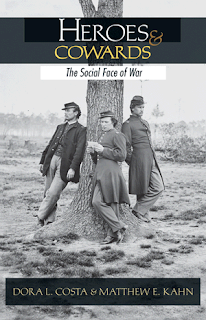 Heroes and Cowards: The Social Face of War, Dora L. Costa and Matthew E. Kahn, Princeton University Press; illustrated with 12 halftones and 13 line illustrations, 1 table, 336 pages, $27.95.
Heroes and Cowards: The Social Face of War, Dora L. Costa and Matthew E. Kahn, Princeton University Press; illustrated with 12 halftones and 13 line illustrations, 1 table, 336 pages, $27.95.When are people willing to sacrifice for the common good? What are the benefits of friendship? How do communities deal with betrayal? And what are the costs and benefits of being in a diverse community? Using the life histories of more than forty thousand Civil War soldiers, Dora Costa and Matthew Kahn answer these questions and uncover the vivid stories, social influences, and crucial networks that influenced soldiers' lives both during and after the war.
Drawing information from government documents, soldiers' journals, and one of the most extensive research projects about Union Army soldiers ever undertaken, Heroes and Cowards demonstrates the role that social capital plays in people's decisions. The makeup of various companies--whether soldiers were of the same ethnicity, age, and occupation--influenced whether soldiers remained loyal or whether they deserted. Costa and Kahn discuss how the soldiers benefited from friendships, what social factors allowed some to survive the POW camps while others died, and how punishments meted out for breaking codes of conduct affected men after the war. The book also examines the experience of African-American soldiers and makes important observations about how their comrades shaped their lives.
Heroes and Cowards highlights the inherent tensions between the costs and benefits of community diversity, shedding light on how groups and societies behave and providing valuable lessons for the present day.
Table of Contents:
List of Plates xv
Preface xvii
Acknowledgments xxiii
Chapter 1: Loyalty and Sacrifice 1
Chapter 2: Why the U.S. Civil War? 26
Chapter 3: Building the Armies 46
Chapter 4: Heroes and Cowards 80
Chapter 5: POW Camp Survivors 120
Chapter 6: The Homecoming of Heroes and Cowards 160
Chapter 7: Slaves Become Freemen 187
Chapter 8: Learning from the Past 215
Appendix: Records and Collection Methods 227
Notes 243
Bibliography 273
Index 291
Blurb: This impressive study, based on a random sample of forty thousand Civil War soldiers both black and white, reaches important conclusions about their motivation and behavior. Its most significant findings emphasize the role of close social networks within companies and regiments in promoting combat performance, preventing desertion, and increasing survival rates in POW camps. Readable and accessible to nonspecialists, this book should find a wide audience among those interested in the Civil War as well as group behavior more generally.
(James McPherson, author of the Pulitzer Prize-winning "Battle Cry of Freedom" )
Text Source: Princeton University Press


No comments:
Post a Comment